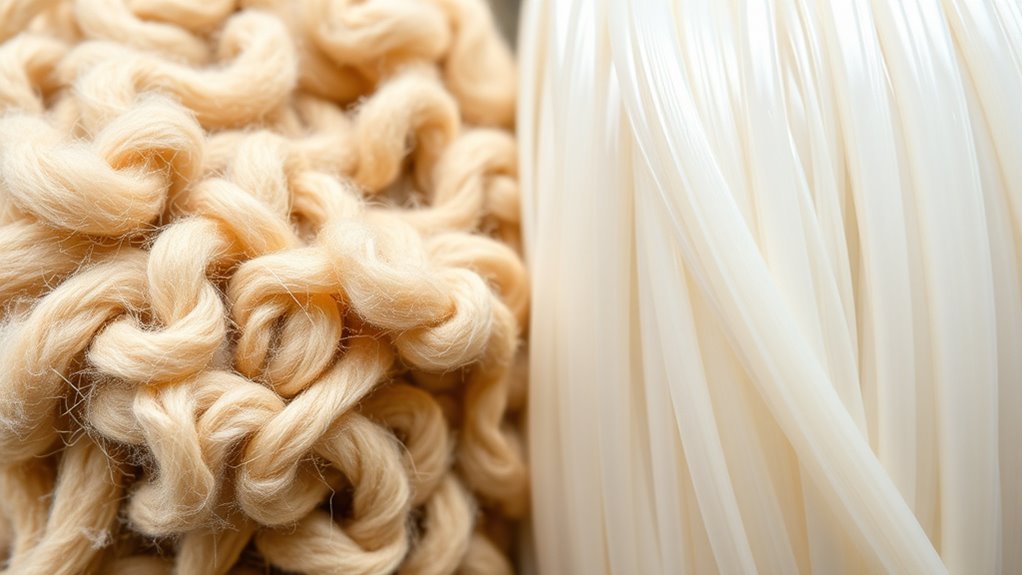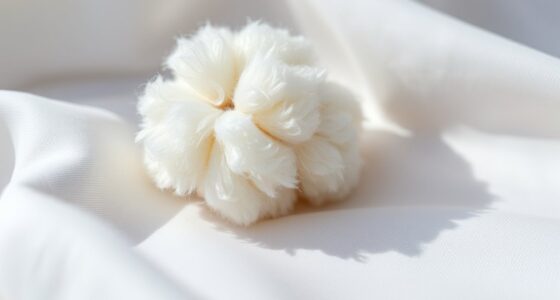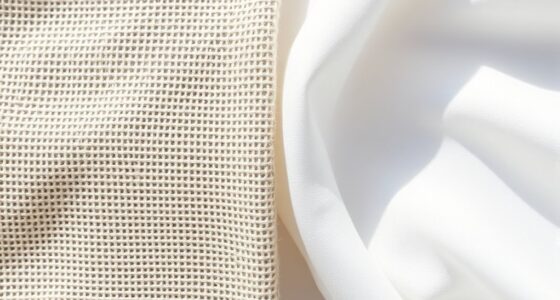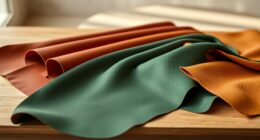When comparing wool and acrylic, you’ll find wool is a natural, resilient fiber that offers warmth and durability, but it needs gentle care to maintain its qualities. Acrylic, on the other hand, mimics wool’s softness and warmth while being easier to care for and resistant to moisture and fading. However, acrylic may pill or wear out faster under heavy use. To discover more about how these fibers differ in longevity and feel, keep exploring the details.
Key Takeaways
- Wool is a natural, durable fiber with high resilience, while acrylic is a synthetic fiber designed to mimic wool’s qualities but may degrade faster.
- Wool resists wear and maintains shape over time, whereas acrylic resists elements but is prone to pilling and fuzzing.
- Wool offers a rich, warm, and luxurious feel, while acrylic provides a softer, smoother, and less itchy surface.
- Wool is eco-friendly, natural, and requires delicate care; acrylic is easier to clean, resistant to moisture, and more maintenance-friendly.
- Wool’s elasticity ensures garments stretch and recover; acrylic’s uniform surface makes it easier to care for but less breathable.

Are you trying to decide between wool and acrylic for your next project? Both fibers have their unique strengths, but understanding their differences can help you make an informed choice. One key aspect to contemplate is fiber durability. Wool, being a natural fiber, tends to be quite resilient; it can withstand repeated use without losing its shape or strength. Its fibers have natural elasticity, which allows garments to stretch and bounce back, making wool items long-lasting if cared for properly. Acrylic, on the other hand, is a synthetic fiber designed to mimic wool’s qualities. While it’s generally durable and resistant to wear and tear, it may not hold up as well over time if subjected to frequent washing or rough treatment. Acrylic fibers can sometimes pill or develop surface fuzziness more quickly than wool, which affects their overall longevity.
Another important point to weigh is the texture comparison. Wool has a rich, natural feel that can range from soft and silky to more coarse textures, depending on the type of wool used. Many find wool’s texture to be cozy and luxurious, especially when it’s fine or merino wool. It offers a warm, comforting touch that’s hard to replicate. Acrylic, however, is known for its smooth, uniform surface. It can be made to feel remarkably similar to wool, but some people notice that it lacks the natural depth and warmth of real wool. Acrylic fibers tend to be softer and more uniform in texture, which can be a benefit if you prefer a slicker, less itchy feel. That said, acrylic often feels less breathable and can sometimes cause static, especially in dry environments.
When comparing fiber durability and texture, it’s clear that wool excels in longevity and natural feel, but it requires more delicate care to maintain its qualities. Acrylic is more resistant to elements like moisture and fading, making it easier to care for and more suitable for items that need frequent cleaning. However, it might not age as gracefully as wool, especially if used heavily or washed improperly. Your choice depends on what you prioritize: if you want something natural, warm, and long-lasting with a rich texture, wool is the way to go. If you prefer something lightweight, low-maintenance, and more affordable, acrylic could be the better choice. Weighing these factors will help you select the fiber that best fits your needs and project expectations.
Frequently Asked Questions
Which Fabric Is More Environmentally Sustainable?
You’ll find acrylic less eco-friendly because it’s made from fossil fuels, a non-renewable resource, and often uses less sustainable dyes. Wool, on the other hand, can be more eco-friendly if sourced responsibly, especially when producers use eco-friendly dyes and sustainable farming practices. By choosing wool, you support renewable resources and environmentally conscious methods, making it a more sustainable option overall.
How Do Wool and Acrylic Compare in Allergy Risks?
Wool and acrylic are like night and day when it comes to allergy risks. Wool generally has hypoallergenic qualities, making it less likely to cause irritation, while acrylic can sometimes trigger allergies or skin irritation because of synthetic fibers. If you have sensitive skin, wool’s natural fibers are gentler and less irritating, whereas acrylic might pose a higher irritation potential. Choose wool for a safer, allergy-friendly option.
Can Wool or Acrylic Be Recycled or Reused?
Yes, both wool and acrylic can be recycled or reused. Recycling processes for wool often involve mechanical or chemical methods to turn old fibers into new yarns, making it highly reusable. Acrylic recycling typically involves melting and remolding into new products. You can also repurpose or donate old garments, giving you reusable options that extend their life. By choosing recycling or reuse, you help reduce waste and support more sustainable fashion choices.
Which Fabric Is Better for Extreme Weather Conditions?
For extreme weather conditions, acrylic is your best choice because it offers superior fiber durability and color retention. You’ll find it resistant to moisture, UV rays, and temperature fluctuations, making it ideal for harsh environments. Wool, while warm and breathable, can lose its insulating properties when wet and is less durable over time. So, if you’re facing tough weather, acrylic provides more reliable performance and longevity.
How Do Washing and Care Requirements Differ?
Think of caring for these fabrics as tending a delicate garden. Wool requires gentle washing, often by hand or on a delicate cycle, to preserve its fabric softness and prevent shrinking. Acrylic is more forgiving, suitable for machine washing, and maintains color retention better over time. Always follow care labels to keep your garments looking vibrant and feeling cozy, ensuring they stay in top shape through many wears.
Conclusion
So, whether you choose wool or acrylic, it’s about what fits your needs. Wool’s natural warmth and durability seem to speak to your love for eco-friendly options, while acrylic’s softness and affordability catch your eye. Sometimes, it feels like the universe nudges you toward comfort and practicality in just the right way. Whichever you pick, trust that your choice reflects what truly matters to you—comfort, style, or maybe both. After all, it’s all about what feels right.










